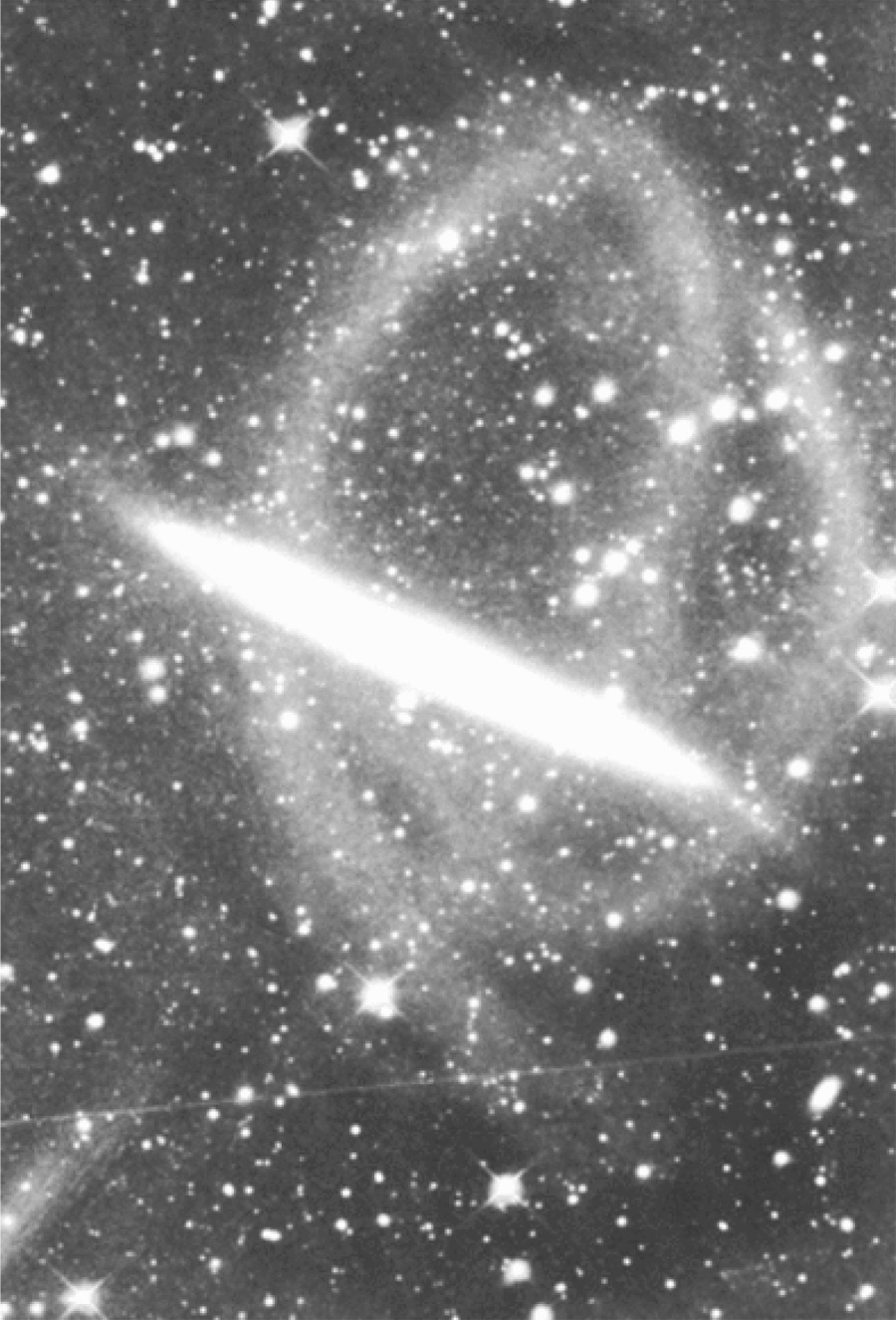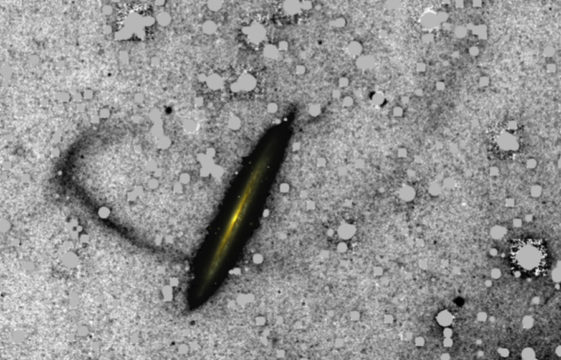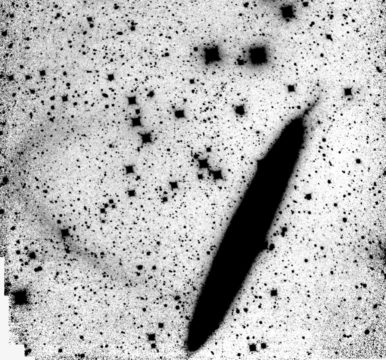A 2008 image captured a stunning double loop of stars around an edge-on galaxy. Now, astronomers are questioning whether one of those loops exists.

D. Martínez-Delgado et al. / The Astrophysical Journal 2008
In 2006, a 20-inch amateur telescope captured an image of an eye-catching double loop of diffuse starlight wrapping around the edge-on galaxy NGC 5907, some 50 million light-years away in Draco, the Dragon. However, two teams of astronomers now say the second part of the double loop doesn’t exist.
The iconic image of NGC 5907 (also known as the Knife Edge Galaxy or the Splinter Galaxy) was obtained by amateur astronomer R. Jay Gabany, using the BlackBird Remote Observatory (BBRO) in Cloudcroft, New Mexico. The results were described in 2008 in The Astrophysical Journal by a team led by David Martínez-Delgado (then at the Max Planck Institute for Astronomy, Germany). In addition to a known diffuse elliptical feature first discovered in 1998 – most likely a tidally disrupted dwarf galaxy – Gabany’s image clearly shows a second loop.
Then the novel Dragonfly telephoto array, which excels at detecting low-surface-brightness features failed to see the second loop. (Read more about Dragonfly in S&T’s May 2019 issue.) “In reality, there’s only one [loop],” says Dragonfly’s co-principal investigator Pieter van Dokkum (Yale University). Van Dokkum and his colleagues published their results in the October 2019 Astrophysical Journal Letters.

Van Dokkum et al. / Astrophysical Journal Letters 2019
Ignacio Trujillo (Institute of Astrophysics of the Canaries, Spain), coauthor on the 2008 paper, was not impressed. He says that the Dragonfly team uses a nonstandard method to quantify the depth of their images. “They [do] not reach particularly deep low surface brightness levels,” he claims, much to the annoyance of van Dokkum. Moreover, other dedicated amateurs have also succeeded in photographing the second loop, Trujillo adds.
But now, a team led by Oliver Müller (University of Strasbourg, France) has observed the Knife Edge Galaxy with the much larger 1.4-meter Milanković telescope in Serbia. They, too, fail to see signs of the second loop, as they write in Astronomy & Astrophysics, but are cautious in their note: “The fact that now two completely independent professional teams were unable to confirm the double loop sheds some doubts on at least some of the previously found very low surface brightness features,” they write.

O. Müller et al. / Astronomy & Astrophysics 2019
Martínez-Delgado counters that at least some of the Milanković images were taken when the galaxy was at relatively low elevation, hampering the detection of extremely diffuse features. “Their data cannot shed light on this controversy and are still consistent with shallow images taken by tens of amateurs with very modest equipment in the last decade,” he says. But according to van Dokkum, “[Müller] put the nail in the coffin of the Martínez-Delgado result.”
So what’s going on? No one knows. Unfortunately, the raw data of the 2006 Gabany image was lost in a hard-drive crash and cannot be reprocessed independently. Moreover, according to van Dokkum, at least some of the confirmation images taken by other amateurs were processed using Gabany’s published image as a template. As Müller and his co-authors write, there’s need for more independent observations that apply consistent scientific processing techniques.
Martínez-Delgado says more follow-up observations by his team are in progress. “I´ll give a suitable answer [to the criticism] in a refereed publication soon,” he says. Adds Trujillo: “I am confident that the mystery will be finally solved later this year.” Meanwhile, if you happen to be a semi-professional astro-imager, why not train your instrument on the Knife Edge and give it a try?
 4
4









Comments
Bob-dBouncier
March 24, 2020 at 5:32 pm
"Unfortunately, the raw data of the 2006 Gabany image was lost in a hard-drive crash and cannot be reprocessed independently."
"...there’s need for more independent observations that apply consistent scientific processing techniques..." Sure, but it sounds like basic digital back-up practices could be used.
You must be logged in to post a comment.
Ian-Cooper
March 27, 2020 at 6:59 pm
You get thrown "through" a loop. Not "for" a loop.
You must be logged in to post a comment.
AB
March 29, 2020 at 11:35 pm
It's a very common idiom.
https://www.merriam-webster.com/dictionary/throw%20%28someone%29%20for%20a%20loop
You must be logged in to post a comment.
sina
April 25, 2020 at 6:13 pm
If the gabany image had The same orientation as the other images it would’ve been so much more helpful to see stuff.
You must be logged in to post a comment.
You must be logged in to post a comment.